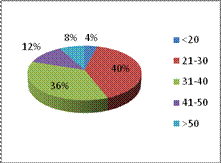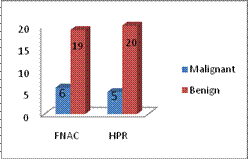 |
|||||||||||||||||||||||||||||||||||||||||||||||||||||||||||||||||||||||||||||||||||||||||||||||||||||||||||
|
|
|||||||||||||||||||||||||||||||||||||||||||||||||||||||||||||||||||||||||||||||||||||||||||||||||||||||||||
 |
|||||||||||||||||||||||||||||||||||||||||||||||||||||||||||||||||||||||||||||||||||||||||||||||||||||||||||
|
|
[Abstract] [PDF] [HTML] [Linked References]
Sabu N. Satihal1*, Eranna R. Palled2# {1Assistant Professor, Department of Surgery} {2Assistant Professor, Department of Radio Diagnosis} Belgaum Institute of Medical Sciences, Belgaum 590001 Karnataka, INDIA. Corresponding Addresses: *drsns558@yahoo.co.in, #drpalled_eranna@yahoo.com Research Article
Abstract: Introduction: Solitary nodule of the thyroid is a common clinical entity though varying in incidence in different geographical regions. Often the swelling have been noticed accidentally by the patient or drawn to his / her attention by a family member, neighbour or friend. Aims and objectives: (1) to study the various clinical presentations of solitary nodule thyroid at KIMS, Hubli. (2) To know the incidence of malignancy in the solitary nodule of thyroid at KIMS, Hubli. Material and methods: present study was conducted in department of surgery of KIMS, Hubli. With pre defined inclusion and exclusion criterion 25 patients of solitary thyroid nodule were selected. All details of patients including clinical findings were entered in the proforma. All the patients were subjected to FNAC and Histopathological examination. Results: 76% patients were from 20 -40 years of age group. 92% of patients were females. Al the patients presented with swelling. Most of the patients presented with less than one year duration of swelling. Right lobe was the most commonly involved lobe. On FNAC 6 patients showed malignant changes. Whereas on histopathopathological examination malignancy was confirmed in 5 patients. Conclusion: In the present study female predominance was observed and peak incidence was 20 -40 years of age. Most common presenting complaint was swelling with right lobe involvement. Incidence of malignancy was 20% among the solitary nodule of thyroid confirmed on histopathological examination. Keywords: Solitary Nodule, Thyroid.
Introduction Solitary nodule of the thyroid is a common clinical entity though varying in incidence in different geographical regions. Often the swelling have been noticed accidentally by the patient or drawn to his / her attention by a family member, neighbour or friend. A Solitary thyroid nodule may become cosmetically distressing to a patient. The optimal management of a thyroid nodule continues to be a source of controversy and the operative intervention recommended by some physicians advocating either observation or thyroid suppression.1 The major concern relates to the potential malignancy with in such a nodule and to the anxiety endangered in-patient because of this. Less frequently an autonomously hyperfunctioning single nodule may cause hyperthyroidism. The basis for this conflict of divergent opinions may stem from the fact that the thyroid nodule undoubtedly has different can notations when considered by the thyroid clinician, thyroid surgeon or the thyroid pathologist. All are concerned with one question and that is the problem of benignancy or malignancy. In the recent years advent of high-resolution ultrasound, improved efficacy of FNAC and better understanding of pathology the management protocols are also changing. Hence preoperative identification of the nodule is likely to contain malignancy is important since treatment approach varies accordingly.2,3 The patients who have such solitary nodules to be always dilemma. Although a great majority of these nodules are benign and significant percentage harbor malignancy. A single nodule in the thyroid is a definite clinical entity with important pathological significance. It is necessary to define the criteria for solitariness. When goitrogenic influences are at work, the opposite lobe is likely to be palpable and visible. Ignoring the palpability of the opposite lobe in considering solitary thyroid nodules, is therefore, likely to lead to a higher proportion of them turning out to be nodular goiters. Another factor which will influence the ultimate histopathological outcome of solitary thyroid nodules is whether the definition of solitariness is entirely clinical or has been extended to include only those nodules which are demonstrated to be single by either radio iodine scan, sonographic studies, operative data, or histologic criteria. Thus the present study was undertaken to study the clinical findings in patients with solitary thyroid nodule and also to study the incidence of malignancy in these patients. Aims and Objectives
Materials and MethodThe present study was conducted in the department of surgery at KIMS, Hubli.All the patients presenting with solitary thyroid nodule during 1st July 2003 to 30th June 2004 were enrolled in the study. Following inclusion and exclusion criterion was used Inclusion criteria
Exclusion criteria
Thus total 25 patients were enrolled in the study in the above specified duration. All the patients were clinical examined and a note was mode of all the clinically details such as age, sex, duration of symptoms, signs and symptoms suggestive of toxicosis and malignancy. After a clinical diagnosis of solitary thyroid nodule, FNAC was done for all the patients, making the cytological diagnosis. They were differentiated into the benign and malignant swellings and treatment was charted out accordingly. To get a uniformity of cases, the history, clinical features, investigations, operative procedures course was recorded in the proforma. The histopathology report was obtained as the final diagnosis. Patient who needed revision surgery as and when indicated by the HPR were referred to cancer hospital.
Results Table 1: Age and sexwise distribution of patients with solitary thyroid nodules
Figure 1: Age wise distribution of patients
Most of the patients were in their 3rd decade and many others in the 4th decade. The youngest was 14 years old and oldest was 70 years. There was a preponderance of females with thyroid nodules in this study with F: M is 23:2
Table 2: Distribution of patients according to presenting symptoms
The maximum number of patients presented within 6 months of the nodule being noticed (60%). All the patients come with the chief complaints of lump in the neck. 8% had some amount of pain and discomfort attributed to the swelling. Toxic symptoms were present in one case (4%). Right lobe was the commonest lobe to be involved in 18 cases (72%) whereas left lobe was involved in 7 cases (28%). Isthmus is not involved in any case. Most of the solitary nodules in this study was less than 6cm and been and oval in shape. Table 3: Distribution of patients according to FNAC and histopathological report
Figure 2: Distribution of patients according to FNAC and histopathological report
On FNAC most of the solitary nodules in this study were benign in nature 76% and 24% of cases were malignant in this study. Whereas on histopthological examination (which is the gold standard investigation) 20% lesion were malignant.
Discussion In the present study the peak incidence of solitary thyroid nodule was observed between 20 to 40 years. Similar observations were reported by Fenn et al4 and Bhansali et al5 in their study. There was a preponderance of females (92%) with thyroid nodules in this study. Fenn et al4 and Bhansali et al5 also found female predominance in their study. All the patients in the study came with swelling as the presenting symptoms. The consistent symptom trait of all patients was the presence of a swelling in the neck as seen also by other workers, the neck as seen also by other workers, the majority of the patients come within the first 2 years of the noticing the swelling (22 Cases 88%). These patients comprised of the more health consciousness patients coming for cosmoses. On the other hand some patients (3 cases) came after 2 years of noticing the swelling. 2,3,6,7 It was observed that right lobe involvement was seen more commonly than left lobe. 84% of patients were having lobe size between 3 -5 cm.FNAC was the mainstay of all investigations on the solitary thyroid nodule. It was performed on all patients; some of the follicular neoplasia was diagnosed by FNAC. However they could not be differentiated into adenoma and carcinoma as this involves visualization of the capsule and its vessels for invasive. It was realized that FNAC as a sole diagnostic procedure is very objective and could be as good only as the performing cytologists with scope for human error and misdiagnosis. Also it is relatively a very safe type of procedure. All the patients were subjected were also subjected for histopathological examination. Out of 25 patients 5 were diagnosed malignancy on histopathological examination.8 Thus incidence of malignancy in the present study was 20%. Similar results were observed by Fenn et al4 and Bhansali et al5.
Conclusion In the present study female predominance was observed and peak incidence was 20 -40 years of age. Most common presenting complaint was swelling. Right lobe involvement was most common. Incidence of malignancy was 20% among the solitary nodule of thyroid.
References
|
||||||||||||||||||||||||||||||||||||||||||||||||||||||||||||||||||||||||||||||||||||||||||||||||||||||||||
|
|||||||||||||||||||||||||||||||||||||||||||||||||||||||||||||||||||||||||||||||||||||||||||||||||||||||||||

